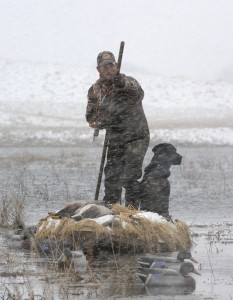Lighting, water temp, more birds, many hunters…
An article from WWA’s Words From The Wardens.
This article originally appeared in Wisconsin Waterfowl Association’s December, 2021 eNewsletter.
 By DNR Warden Ryan Mannes/Dodge County
By DNR Warden Ryan Mannes/Dodge County
I serve the public and tourists who are proud to either call Dodge County their home or the place they literally flock to in pursuit of outdoor fun, different scenery and a whole lot of birds – make that migratory birds.
The late season arrives on the heels of the dropping temperatures and is known in my warden world as one of the most dangerous times to be out. However, the danger can evaporate as quickly as the first snow on warm ground if we all just remember some safety.
DUCK HUNTING: This is the life
 Duck hunting isn’t just a hobby or outdoor recreation activity for the folks of Dodge County, it is the culture and a way of life. With the Horicon Marsh, the rivers and lakes of Dodge County, many hunters do their own version of migration to chase some ducks at Horicon.
Duck hunting isn’t just a hobby or outdoor recreation activity for the folks of Dodge County, it is the culture and a way of life. With the Horicon Marsh, the rivers and lakes of Dodge County, many hunters do their own version of migration to chase some ducks at Horicon.
As the temperatures drop, the ducks start to migrate from the north, providing some excellent hunting opportunities. Mid- to late-November can provide the largest numbers of birds in the Dodge County area. Many hunters will voyage out on the waters of Dodge County by boat, canoe or skiff throughout November and into December for a chance to fill their waterfowl bag limits.
While the lure of Horicon to the waterfowl hunter is easily understood, we wardens want to make sure hunters at Horicon – and everywhere statewide – are ready to enjoy their outing with their safety skills in the boat.
BIG SAFETY 3
Here are my top three areas I stress with waterfowl hunters – and I meet a lot of them this time of the year.
- Safety equipment: Make sure you have on board the required number of personal flotation devices – also known as life jackets. While it is not required, the DNR and the wardens strongly recommend wearing a life jacket any time on the water or near the water. Wearing a life jacket could save a duck hunter’s life in the event of a fall overboard – as waders and frigid waters do not mix! Every boat, including canoes/kayaks/skiffs, must have at least one wearable personal flotation device on board. If your boat is greater than 16’ in length, you must carry a Type IV throwable on board. Remember to also carry a fire extinguisher, as well as having your battery terminals covered and strapped down.
- Know the limits of your boat: Typically, waterfowl hunters are carrying a large quantity of gear. For a smaller boat, it doesn’t take much to reach the maximum weight capacity for the vessel. Remember that the boat capacity plate will display the weight restriction, including motor, people and gear. Knowing the capabilities of your boat will help waterfowl hunters avoid a potentially hazardous situation. It is also important to have a motor that is in good working condition.
- Have a plan: Many of our duck hunting destinations are often littered with hazards. Before heading out in the early hours of the morning, it is highly recommended that waterfowl hunters scout during daylight hours and make themselves aware of any potential hazards. There are many stumps, rocks and other hazards that could damage the hull of any duck boat.
The DNR wardens’ top priority is always safety.
We want everyone to have a safe, fun and successful waterfowl season. If you follow the safety precautions listed above, you will be able to do just that. Enjoy the remainder of the season and remember to contact the DNR Tip Hotline if you observe any violations: 1-800-847-9367.
